This article needs additional citations for verification .(December 2009) |

Agriculture in Uruguay constitutes a significant factor in the economic life of the country.
This article needs additional citations for verification .(December 2009) |

Agriculture in Uruguay constitutes a significant factor in the economic life of the country.
Agriculture played such an important part in Uruguayan history and national identity until the middle of the 20th century that the entire country was then sometimes likened to a single huge estancia (agricultural estate) with Montevideo, where the wealth generated in the hinterland was spent, as its casco or administrative head. As another saying went, "Uruguay es la vaca y el puerto" ("Uruguay is the cow and the port"). However, when world market prices for Uruguay's main export commodities like beef and wool fell drastically in the 1950s, the country's prosperous golden era came to an end.
In 2018, the country produced 1.36 million tons of rice, 1.33 million tons of soy, 816 thousand tons of maize, 637 thousand tons of barley, 440 thousand tons of wheat, 350 thousand tons of sugar cane, 106 thousand tons of orange, 104 thousand tons of grape, 90 thousand tons of rapeseed, 87 thousand tons of potato, 76 thousand tons of sorghum, 71 thousand tons of tangerine, 52 thousand tons of oats, 48 thousand tons of apple, in addition to smaller yields of other agricultural products. [1]
Uruguay is also a major meat producer. In 2018, it produced 589 thousand tons of beef. [2]
Today, agriculture still contributes roughly 10% to the country's GDP and is the main foreign exchange earner, putting Uruguay in line with other agricultural exporters like Brazil, Canada and New Zealand. Uruguay is a member of the Cairns Group of exporters of agricultural products. Uruguay's agriculture has relatively low inputs of labour, technology and capital in comparison with other such countries, which results in comparatively lower yields per hectare but also opens the door for Uruguay to market its products as "natural" or "ecological."
Campaigns like “Uruguayan grass-fed beef” and “Uruguay Natural” aim to establish Uruguay as a premium brand in beef, wine and other food products.

Estancia tourism is based upon traditional, historical elements of Uruguay and the remaining resources of the historic ranches (estancias) from Uruguay's "Golden Era".

The economy of the Dominican Republic is the seventh largest in Latin America, and is the largest in the Caribbean and Central American region. The Dominican Republic is an upper-middle income developing country with important sectors including mining, tourism, manufacturing, energy, real estate, infrastructure, telecommunications and agriculture. The Dominican Republic is on track to achieve its goal of becoming a high-income country by 2030, and is expected to grow 79% in this decade. The country is the site of the single largest gold mine in Latin America, the Pueblo Viejo mine. Although the service sector is currently the leading employer of Dominicans, agriculture remains an important sector in terms of the domestic market and is in second place in terms of export earnings. Tourism accounts for more than $7.4 billion in annual earnings in 2019. Free-trade zone earnings and tourism are the fastest-growing export sectors. A leading growth engine in the Free-trade zone sector is the production of medical equipment for export having a value-added per employee of $20,000 USD, total revenue of $1.5 billion USD, and a growth rate of 7.7% in 2019. The medical instrument export sector represents one of the highest-value added sectors of the country's economy, a true growth engine for the country's emerging market. Remittances are an important sector of the economy, contributing $8.2 billion in 2020. Most of these funds are used to cover household expenses, such as housing, food, clothing, health care and education. Secondarily, remittances have financed businesses and productive activities. Thirdly, this combined effect has induced investment by the private sector and helps fund the public sector through its value-added tax. The combined import market including the free-trade-zones amounts to a market of $20 billion a year in 2019. The combined export sector had revenues totaling $11 billion in 2019. The consumer market is equivalent to $61 billion in 2019. An important indicator is the average commercial loan interest rate, which directs short-term investment and stimulates long-term investment in the economy. It is currently 8.30%, as of June 2021.

The economy of Uruguay features an export-oriented agricultural sector and a well-educated workforce, along with high levels of social spending. Tourism and banking are also prominent sectors; Uruguay acts as a regional hub for international finance and tourism. The country also has a history and representation of advanced workers-rights protection, with unions and the eight-hour work-day protected at the beginning of the 20th century.

The economy of Mozambique is $14.396 billion by gross domestic product as of 2018, and has developed since the end of the Mozambican Civil War (1977–1992). In 1987, the government embarked on a series of macroeconomic reforms, which were designed to stabilize the economy. These steps, combined with donor assistance and with political stability since the multi-party elections in 1994, have led to dramatic improvements in the country's growth rate. Inflation was brought to single digits during the late 1990s, although it returned to double digits in 2000–02. Fiscal reforms, including the introduction of a value-added tax and reform of the customs service, have improved the government's revenue collection abilities.
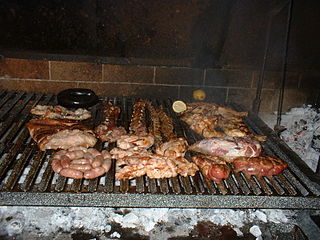
Beef is a key component of traditional Argentine cuisine. In 2019, Argentina was the 4th largest producer of beef, with a production of 3 million tons.
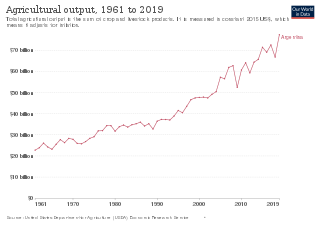
Agriculture is one of the bases of Argentina's economy.
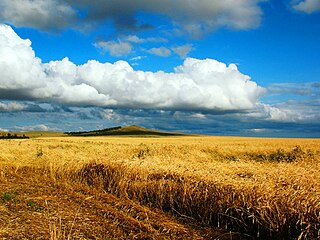
Agriculture in Kazakhstan remains a small scale sector of Kazakhstan's economy. Agriculture's contribution to the GDP is under 10% – it was recorded as 6.7%, and as occupying only 20% of labor. At the same time, more than 70% of its land is occupied in crops and animal husbandry. Compared to North America, a relatively small percentage of land is used for crops, with the percentage being higher in the north of the country. 70% of the agricultural land is permanent pastureland.

The agriculture of Brazil is historically one of the principal bases of Brazil's economy. As of 2024 the country is the second biggest grain exporter in the world, with 19% of the international market share, and the fourth overall grain producer. Brazil is the world's largest exporter of many popular agriculture commodities like coffee, soybeans, organic honey, beef, poultry, cane sugar, açai berry, orange juice, yerba mate, cellulose, tobacco, and the second biggest exporter of maize, pork, cotton, and ethanol. The country also has a significant presence as producer and exporter of rice, wheat, eggs, refined sugar, cocoa, beans, nuts, cassava, sisal fiber, and diverse fruits and vegetables.
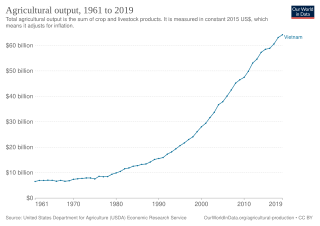
Agriculture's share of GDP has declined in recent years, falling from 42% in 1989, to 26% in 1999. In 2023, agriculture and forestry accounted for about 12% of Vietnam's gross domestic product (GDP). However, agricultural employment was much higher than agriculture's share of GDP; in 2005, approximately 60 percent of the employed labor force was engaged in agriculture, forestry, and fishing. Agricultural products accounted for 30 percent of exports in 2005. The relaxation of the state monopoly on rice exports transformed the country into the world's second or third largest rice exporter. Other cash crops are coffee, cotton, peanuts, rubber, sugarcane, and tea.

Agriculture in Colombia refers to all agricultural activities, essential to food, feed, and fiber production, including all techniques for raising and processing livestock within the Republic of Colombia. Plant cultivation and livestock production have continuously abandoned subsistence agricultural practices in favour of technological farming resulting in cash crops which contribute to the economy of Colombia. The Colombian agricultural production has significant gaps in domestic and/or international human and animal sustenance needs.

Agriculture in Ghana consists of a variety of agricultural products and is an established economic sector, providing employment on a formal and informal basis. It is represented by the Ministry of Food and Agriculture. Ghana produces a variety of crops in various climatic zones which range from dry savanna to wet forest which run in east–west bands across Ghana. Agricultural crops, including yams, grains, cocoa, oil palms, kola nuts, and timber, form the base of agriculture in Ghana's economy. In 2013 agriculture employed 53.6% of the total labor force in Ghana.

Agriculture employs the majority of Madagascar's population. Mainly involving smallholders, agriculture has seen different levels of state organisation, shifting from state control to a liberalized sector.

Agriculture in Kenya dominates Kenya's economy. 15–17 percent of Kenya's total land area has sufficient fertility and rainfall to be farmed, and 7–8 percent can be classified as first-class land. In 2006, almost 75 percent of working Kenyans made their living by farming, compared with 80 percent in 1980. About one-half of Kenya's total agricultural output is non-marketed subsistence production.

Agriculture in Portugal is based on small to medium-sized family-owned dispersed units; however, the sector also includes larger-scale intensive farming export-oriented agrobusinesses backed by companies. The extent of cooperative organisation has been reaching a greater importance with globalization. Portugal produces a wide variety of products, including green vegetables, rice, corn, wheat, barley, olives, oilseeds, nuts, cherries, bilberry, table grapes and edible mushrooms. Forestry has also played an important economic role among the rural communities and industry. In 2013, the gross agricultural product accounted for 2.4% of the GDP. Portugal is the largest world producer of both cork and carob, as well as the third largest exporter of chestnut and the third largest European producer of pulp. Portugal is among the top ten largest olive oil producers in the world and is the fourth biggest exporter. The country is also one of the world's largest exporters of wine, being reputed for its fine wines. The land area of slightly more than 9.2 million hectares was classified as follows : 2,755 arable land and permanent crops, 530 permanent pasture, 3,640 forest and woodland, and 2,270 other land.
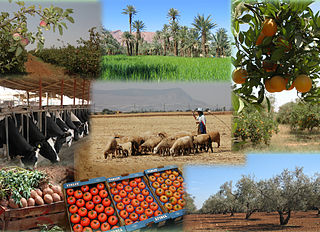
Agriculture in Morocco employs about 40% of the nation's workforce. Thus, it is the largest employer in the country. In the rainy sections of the northwest, barley, wheat, and other cereals can be raised without irrigation. On the Atlantic coast, where there are extensive plains, olives, citrus fruits, and wine grapes are grown, largely with water supplied by artesian wells. Livestock are raised and forests yield cork, cabinet wood, and building materials. Part of the maritime population fishes for its livelihood. Agadir, Essaouira, El Jadida, and Larache are among the important fishing harbors. Both the agriculture and fishing industries are expected to be severely impacted by climate change.

Throughout its history, agriculture in Paraguay has been the mainstay of the economy. This trend has continued today and in the late 1980s the agricultural sector generally accounted for 48 percent of the nation's employment, 23 percent of GDP, and 98 percent of export earnings. The sector comprised a strong food and cash crop base, a large livestock subsector including cattle ranching and beef production, and a vibrant timber industry.

Agriculture plays a crucial role in the lives of Zimbabweans in rural and urban areas. Most of the people in rural areas survive on agriculture and they need support for them to get good yields.

Like the rest of the economy, agriculture in Estonia has been in great flux since the degeneration of the collective and state farm systems.

Agriculture in Saudi Arabia is focused on the export of dates, dairy products, eggs, fish, poultry, fruits, vegetables, and flowers to markets around the world after achieving self-sufficiency in the production of such products. The government of Saudi Arabia is heavily involved in the agriculture industry and subsidizing corporate farming and the Ministry of Environment, Water and Agriculture is primarily responsible for agricultural policy. In the private sector, farmers receive long-term interest-free government loans and low-cost water, fuel, electricity, and duty-free imports of raw materials and machinery.

Agriculture in Suriname is the third largest industry in Suriname, in the economy, employing between 9-15% percent of the workforce, and account for 9% of GDP. Agriculture accounts for 40% of carbon emissions in Suriname, and is an important part of Suriname's policies as part of its Nationally Determined Contributions.
Mozambique has a variety of regional cropping patterns; agro-climatic zones range from arid and semi-arid to the sub-humid zones to the humid highlands. The most fertile areas are in the northern and central provinces, which have high agro-ecological potential and generally produce agricultural surpluses. Southern provinces have poorer soils and scarce rainfall, and are subject to recurrent droughts and floods.